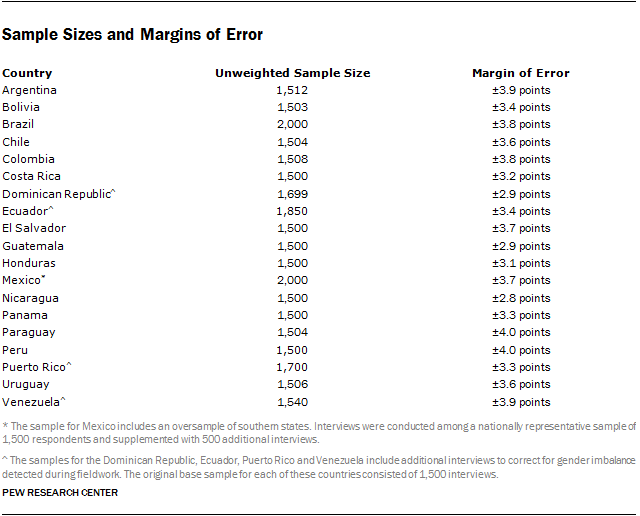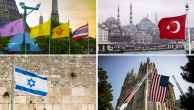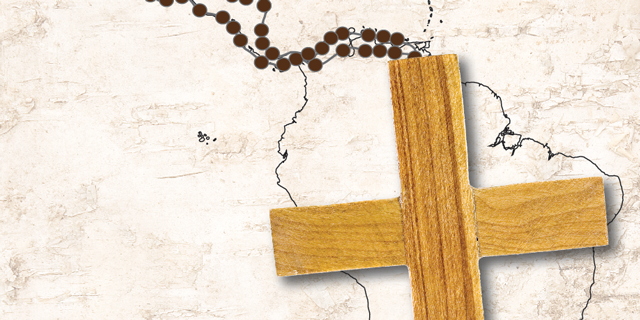
Latin America is home to more than 425 million Catholics – nearly 40% of the world’s total Catholic population – and the Roman Catholic Church now has a Latin American pope for the first time in its history. Yet identification with Catholicism has declined throughout the region, according to a major new Pew Research Center survey that examines religious affiliations, beliefs and practices in 18 countries and one U.S. territory (Puerto Rico) across Latin America and the Caribbean.
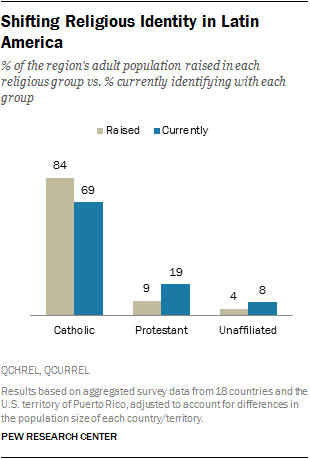
Historical data suggest that for most of the 20th century, from 1900 through the 1960s, at least 90% of Latin America’s population was Catholic (See History of Religious Change). Today, the Pew Research survey shows, 69% of adults across the region identify as Catholic. In nearly every country surveyed, the Catholic Church has experienced net losses from religious switching, as many Latin Americans have joined evangelical Protestant churches or rejected organized religion altogether. For example, roughly one-in-four Nicaraguans, one-in-five Brazilians and one-in-seven Venezuelans are former Catholics.
Overall, 84% of Latin American adults report that they were raised Catholic, 15 percentage points more than currently identify as Catholic. The pattern is reversed among Protestants and people who do not identify with any religion: While the Catholic Church has lost adherents through religious switching, both Protestant churches and the religiously unaffiliated population in the region have gained members. Just one-in-ten Latin Americans (9%) were raised in Protestant churches, but nearly one-in-five (19%) now describe themselves as Protestants. And while only 4% of Latin Americans were raised without a religious affiliation, twice as many (8%) are unaffiliated today.
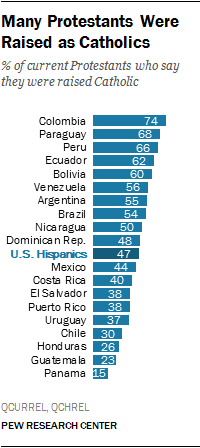
Much of the movement away from Catholicism and toward Protestantism in Latin America has occurred in the span of a single lifetime. Indeed, in most of the countries surveyed, at least a third of current Protestants were raised in the Catholic Church, and half or more say they were baptized as Catholics. For example, nearly three-quarters of current Protestants in Colombia were raised Catholic, and 84% say they were baptized as Catholics.
The survey asked former Catholics who have converted to Protestantism about the reasons they did so. Of the eight possible explanations offered on the survey, the most frequently cited was that they were seeking a more personal connection with God. Many former Catholics also said they became Protestants because they wanted a different style of worship or a church that helps its members more.
Smaller percentages of converts to Protestantism also cite other factors – such as health or family problems (a regional median of 20%) or marriage to a non-Catholic (median of 9%) – as important reasons why they are no longer Catholic.
Most tables and charts in this report cite country-level findings. But on some questions, regional medians are reported to help readers see cross-national patterns. The median is the middle number in a list of numbers sorted in ascending or descending order. In a survey of 18 countries and Puerto Rico, the median result is 10th on a list of country-level findings ranked from highest to lowest.
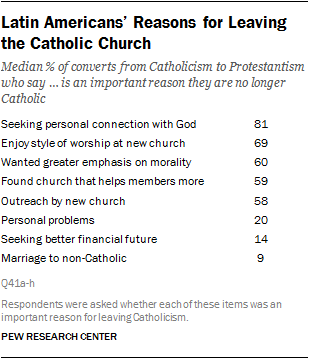
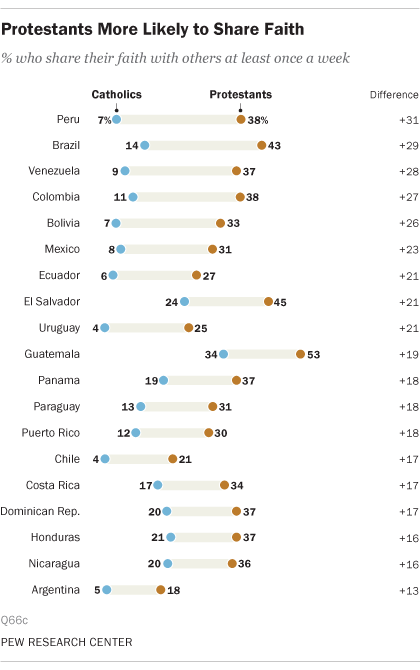
In addition, evangelization efforts by Protestant churches seem to be having an impact: Across Latin America, more than half of those who have switched from the Catholic Church to Protestantism say their new church reached out to them (median of 58%). And the survey finds that Protestants in the region are much more likely than Catholics to report sharing their faith with people outside their own religious group.
While the movement from Catholicism to Protestantism has occurred among people of all ages and socio-economic levels, the survey reveals some broad demographic patterns among converts. In most countries surveyed, pluralities of Catholic-to-Protestant converts say they left Catholicism before the age of 25. Geographic mobility may also be associated with conversion. In a few countries – Brazil, the Dominican Republic and Nicaragua – Catholic-to-Protestant converts are significantly more likely than current Catholics to have changed their place of residence, rather than to have always lived in one place.1 And in a few other countries – Argentina, Bolivia and Costa Rica – converts to Protestantism are less likely than Catholics to have a secondary education, though in most places, there are no statistically significant differences between the education levels of current Catholics and those who have converted.
A “Francis Effect”?
The Catholic Church’s status in Latin America has drawn more attention since Cardinal Jorge Mario Bergoglio of Argentina was elected pope in March 2013, taking the name Francis. While it is too soon to know whether Francis can stop or reverse the church’s losses in the region, the new survey finds that people who are currently Catholic overwhelmingly view Francis favorably and consider his papacy a major change for the church.
But former Catholics are more skeptical about Pope Francis. Only in Argentina and Uruguay do majorities of ex-Catholics express a favorable view of the pope. In every other country in the survey, no more than roughly half of ex-Catholics view Francis favorably, and relatively few see his papacy as a major change for the Catholic Church. Many say it is too soon to have an opinion about the pope. (For details, see Chapter 9.)
Protestants in Latin America, like Protestants elsewhere, belong to a diverse group of denominations and independent churches. But unlike in the United States, where the labels “born again” and “evangelical” set certain Protestants apart, in Latin America “Protestant” and “evangelical” often are used interchangeably.
In this report, “Protestants” is broadly used to refer to members of historical Protestant churches (e.g., Baptists, Seventh-day Adventists, Methodists, Lutherans or Presbyterians), members of Pentecostal churches (e.g., Assemblies of God, the Pentecostal Church of God or the Quadrangular Evangelical Church) and members of other Protestant churches. Fewer than a quarter of Protestants in most countries surveyed say they belong to a historical Protestant church. Roughly half say they belong to a Pentecostal church. And, in most countries, at least a quarter say they belong to another Protestant church or that they do not know their denomination. Among those who belong to Pentecostal churches, Assemblies of God is one of the most commonly cited affiliations. (See topline for full results.)
Religious Observance
The new survey finds that Protestants in Latin America tend to be more religiously observant than Catholics. In nearly every country surveyed, Protestants say they go to church more frequently and pray more often than do Catholics; a regional median of 83% of Protestants report attending church at least once a month, compared with a median of 62% of Catholics. Protestants also are more likely than Catholics to read scripture outside of religious services, to approach the Bible literally and to believe that Jesus will return during their lifetime. (For more details, see Chapters 2 and 3.)
Appeal of Pentecostalism and Afro-Caribbean Religions
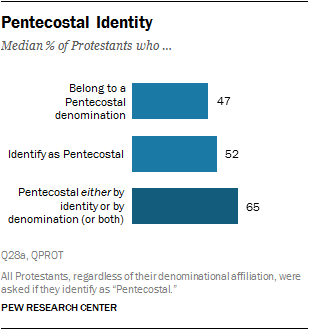
“Evangélicos” – as Protestants in the region often are called – include many Christians who belong to Pentecostal churches. While practices vary, Pentecostal worship services often involve experiences that believers consider “gifts of the Holy Spirit,” such as divine healing, speaking in tongues and receiving direct revelations from God. Across all 18 countries and Puerto Rico, a median of
nearly two-thirds of Protestants (65%) identify as Pentecostal Christians, either because they belong to a Pentecostal denomination (median of 47%) or because they personally identify as Pentecostal regardless of their denomination (median of 52%). Some Protestants identify as Pentecostal in both ways.
Although many Catholics in Latin America also say they have witnessed divine healing or other gifts of the Holy Spirit, these experiences are much less common in Catholic churches than in Protestant congregations. (For more details, see Chapter 4.)
Many Latin Americans – including substantial percentages of both Catholics and Protestants – say they subscribe to beliefs and practices often associated with Afro-Caribbean, Afro-Brazilian or indigenous religions. For example, at least a third of adults in every country surveyed believe in the “evil eye,” the idea that certain people can cast curses or spells that cause harm. Beliefs in witchcraft and reincarnation also are widespread, held by 20% or more of the population in most countries. Other beliefs and practices vary widely from country to country. For instance, a majority of Mexicans (60%) and more than a third of Bolivians (39%) say they make offerings of food, drinks, candles or flowers to spirits, but just one-in-ten Uruguayans (9%) do so. Overall, the survey finds the highest levels of indigenous or Afro-Caribbean religious practice in Panama, where most people (58%) – including 66% of Panamanian Catholics and 46% of Protestants – engage in at least three out of the eight indigenous beliefs and practices mentioned in the survey.
Differing Views on Social Issues and Helping the Poor
Even though the Catholic Church opposes abortion and same-sex marriage, Catholics in Latin America tend to be less conservative than Protestants on these kinds of social issues. On average, Catholics are less morally opposed to abortion, homosexuality, artificial means of birth control, sex outside of marriage, divorce and drinking alcohol than are Protestants.
The differences between Catholics and Protestants on most of these issues hold true even when accounting for levels of religious observance. For example, Protestants who participate in religious services at least once a week are somewhat more likely to oppose abortion and divorce – and considerably more likely to oppose homosexuality, sex outside of marriage and drinking alcohol – than are Catholics who attend Mass at least weekly.2 These differing views on social issues may help explain why many former Catholics who have become Protestants say they were looking for a church that “places greater importance on living a moral life” (a median of 60%).
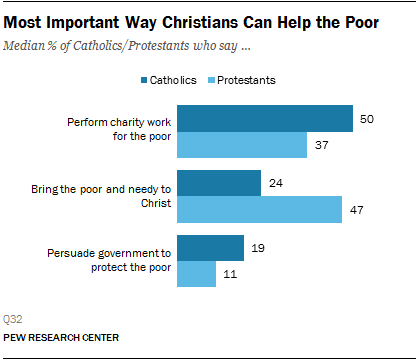
Across the region, both Catholics and Protestants generally say it is incumbent on Christians to help the poor in their societies, but they give somewhat different answers on how best to achieve this goal. When asked what is the most important way Christians can help the poor and needy, Protestants are more likely than Catholics to point toward bringing the poor to Christ, while Catholics are more inclined to say that performing charity work for the poor is most important.
Yet across the countries surveyed, a considerably higher share of Protestants than Catholics say that they themselves or the church they attend engage in charity work – helping people find jobs, providing food and clothing for those in need or organizing other community initiatives to help the poor. (For more details, see Chapter 6.)
These are among the key findings of more than 30,000 face-to-face interviews conducted across 18 countries and Puerto Rico by the Pew Research Center between October 2013 and February 2014. The survey encompasses nearly all Spanish- and Portuguese-speaking countries and territories stretching from Mexico through Central America to the southern tip of South America. Due to fieldwork constraints and sensitivities related to polling about religion, Cuba could not be included; it is the only Spanish-speaking country in Latin America that was not polled.
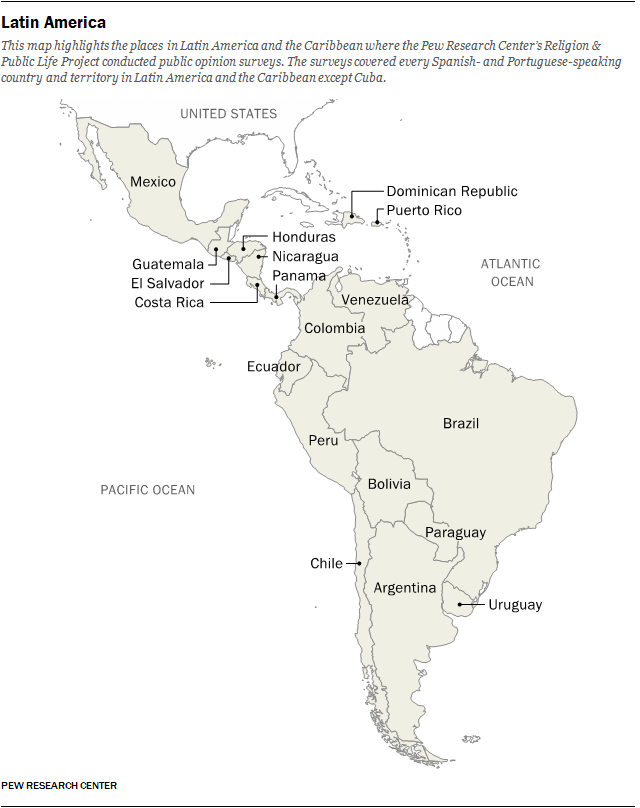
The survey of Latin America is part of a larger effort, the Pew-Templeton Global Religious Futures project, which analyzes religious change and its impact on societies around the world. The Global Religious Futures project is funded by The Pew Charitable Trusts and the John Templeton Foundation.
The remainder of this Overview explains the major findings in greater detail and provides additional context, beginning with some comparisons with Hispanics living in the United States.
Comparisons with U.S. Hispanics
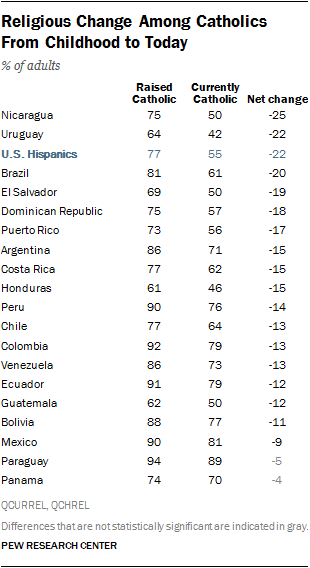
Many of the major patterns revealed by this survey mirror trends found among U.S. Hispanics, according to a 2013 Pew Research poll. The U.S. Hispanic population (now approximately 54.1 million people) is larger than the total population in all but two Latin American countries – Brazil (195 million) and Mexico (113 million).
Nearly a quarter of Hispanic adults in the United States were raised Catholic but have since left the faith (24%), while just 2% of U.S. Hispanics have converted to Catholicism after being raised in another religious tradition or with no affiliation – a net drop of 22 percentage points. The scale of this exodus is roughly on par with several Latin American countries that also have experienced steep declines in the share of adults who identify as Catholic, including Nicaragua (minus 25 percentage points), Uruguay (minus 22 points), Brazil (minus 20) and El Salvador (minus 19).
Like their counterparts in Latin America, many U.S. Hispanics have left Catholicism for Protestant churches. Protestants now account for about one-in-five Hispanics in the United States (22%), roughly the same as in Latin America (19%). In addition, a substantial number of Hispanics in the United States (18%) describe their religion as atheist, agnostic or nothing in particular. This is more than double the percentage of Latin American adults (8%) who are religiously unaffiliated.
Religious Affiliations of Latin Americans and U.S. Hispanics
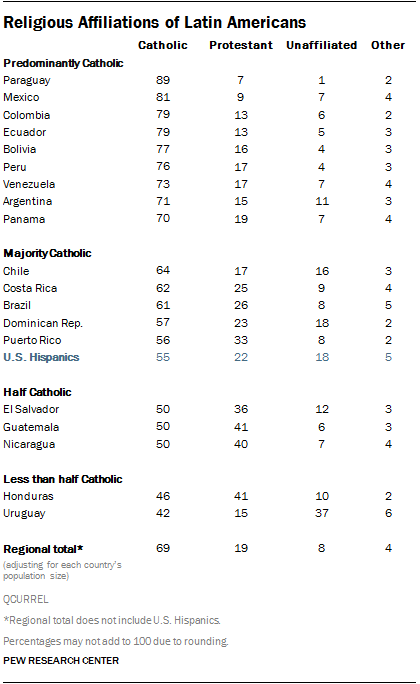
Although Catholicism’s historically dominant position has weakened in recent decades (see History of Religious Change), it remains the majority religion across much of Latin America. Catholics make up an overwhelming majority (more than two-thirds) of the adult population in nine of the countries surveyed, ranging from 89% in Paraguay to 70% in Panama. Even in these heavily Catholic countries, however, Protestants now are a significant minority, constituting nearly 10% or more of the population in each country.
Catholics make up between one-half and roughly two-thirds of the population in five of the places surveyed: Chile, Costa Rica, Brazil, the Dominican Republic and Puerto Rico. Similarly, 55% of U.S. Hispanics are Catholic.
In three Central American countries – El Salvador, Guatemala and Nicaragua – about half of the population is Catholic, while roughly four-in-ten adults describe themselves as Protestant.
Uruguay is the only country surveyed where the percentage of adults who say they are religiously unaffiliated (37%) rivals the share who identify as Catholic (42%). In addition, 15% of Uruguayans identify as Protestant. (See Religion in Uruguay.)
The Influence of Pentecostalism
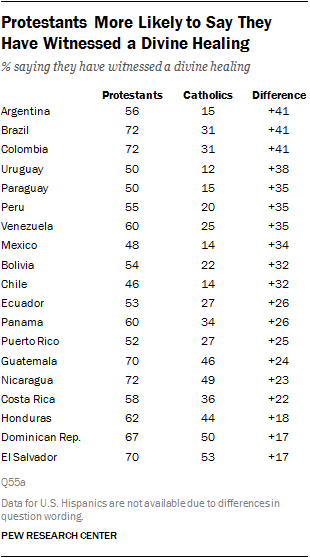
Most Protestants in Latin America identify with Pentecostalism. Across 18 countries and Puerto Rico, a median of 65% of Protestants either say they belong to a church that is part of a Pentecostal denomination (median of 47%) or personally identify as a Pentecostal Christian regardless of their denomination (median of 52%), with some overlap between the categories. In the United States, fewer than half of Hispanic Protestants describe themselves as Pentecostal by church denomination (29%), self-identification (42%) or both (45%). In addition, 46% of Hispanic Catholics in the U.S. and a median of 40% of Catholics across Latin America say they are “charismatic” – a term used to describe Catholics who incorporate beliefs and practices associated with Pentecostalism into their worship.3
Significant percentages of Protestants across Latin America say that they engage in beliefs and practices associated with “gifts of the Holy Spirit,” such as divine healing and exorcism. In a majority of the countries surveyed, at least half of Protestants report that they have witnessed or experienced the divine healing of an illness or injury, and at least a third say they have experienced or witnessed the devil being driven out of a person.
Smaller but substantial shares of Catholics also report charismatic experiences. This is especially true in parts of Central America and the Caribbean, where roughly half of Catholics in El Salvador (53%), the Dominican Republic (50%), Nicaragua (49%) and Guatemala (46%) report that they have witnessed or experienced a divine healing. At least one-in-five Catholics in the Dominican Republic (36%), Honduras (26%), Guatemala (23%), Nicaragua (23%), Venezuela (22%), Panama (21%) and Colombia (21%) say they have been present for an exorcism.
The survey also asked respondents about “speaking in tongues” – a practice closely associated with Pentecostalism around the world. In a majority of the countries polled, at least one-in-five Protestants say they personally have spoken in tongues, including about four-in-ten in Panama (39%) and a third in Brazil (33%). By comparison, relatively few Catholics report speaking in tongues, ranging from 1% in Argentina, Chile and Panama to 12% in Guatemala.
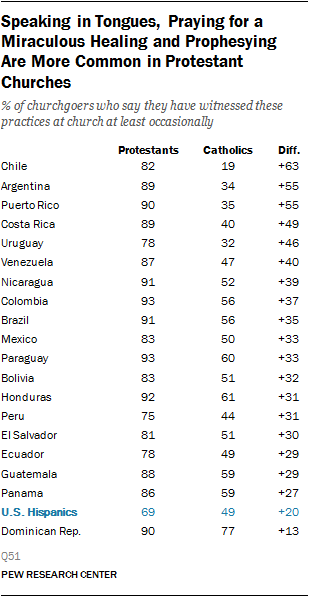
The survey also asked churchgoing respondents how often they see fellow worshipers speaking in tongues, praying for a miraculous healing or “prophesying” (spontaneously uttering a message or “word of knowledge” believed to come from the Holy Spirit). Most Latin American Protestants say that speaking in tongues, praying for a miraculous healing and prophesying are frequent occurrences in their religious services. Fewer Catholics say that such behaviors are on display during Catholic worship services, and majorities of Catholics in Uruguay (63%), Argentina (61%) and Puerto Rico (60%) report that speaking in tongues, praying for a miraculous healing and prophesying are never part of their worship practices.
In several countries in Latin America, however, at least half of Catholics say they have witnessed these practices during Mass at least occasionally. For example, majorities of Catholics in the Dominican Republic (77%), Honduras (61%) and Paraguay (60%) say they have witnessed fellow worshipers speaking in tongues, praying for a miraculous healing or prophesying. (For definitions of terms, see the glossary.)
The Religiously Unaffiliated
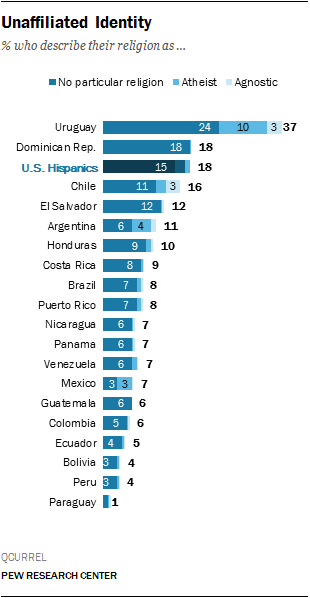
Latin America’s religious landscape is being reshaped not only by people who have switched from Catholic to Protestant churches but also by those who have given up any affiliation with organized religion. The unaffiliated category includes individuals who describe themselves as atheist, agnostic or having no particular religion.
Uruguay is home to the largest percentage of religiously unaffiliated adults in Latin America (37%), roughly double the share of unaffiliated people in any other country in the region. (See Religion in Uruguay.)
Across Latin America, as well as among Hispanics in the United States, most people who are unaffiliated say that they have no particular religion rather than describing themselves as atheist or agnostic. About one-in-ten or more adults in Uruguay (24%), the Dominican Republic (18%), El Salvador (12%) and Chile (11%) say they have no particular religion. In the United States, 15% of Hispanics fall into this category.
Religion in Uruguay
On many questions in the survey, Uruguay is an outlier, far and away Latin America’s most secular country. Fully 37% of Uruguayans say that they have no particular religion or are atheist or agnostic. In no other Latin American country surveyed do the religiously unaffiliated make up even 20% of the population.
Laicidad, or the separation of religion and the state, has a long history in Uruguay. In 1861, the government nationalized cemeteries across the country, breaking their affiliations with churches. Soon after, the government prohibited churches from having a role in public education or issuing marriage certificates.4 Secularization continued in the 20th century: A new constitution enshrined the separation of religion from public life, references to God were removed from the parliamentary oath and religious references were dropped from the names of cities and villages.5
Today, Uruguay has by far the lowest levels of religious commitment among the countries polled. Fewer than a third of Uruguayans (28%) say that religion is very important in their lives; in no other country surveyed do fewer than four-in-ten people say this. Relatively few Uruguayans say they pray daily (29%) or attend religious services weekly (13%). In neighboring Brazil, by contrast, 61% of adults say they pray daily, and 45% report attending services at least once a week.
When it comes to social views and attitudes toward morality, Uruguay consistently stands out for its liberalism. It is the only country surveyed where a majority of the public favors allowing same-sex couples to legally marry (62%), and where as many as half of adults (54%) say that abortion should be legal in all or most cases. And it is the only country in the region where a majority (57%) says that religious leaders should have “no influence at all” in political matters.
Religious Commitment
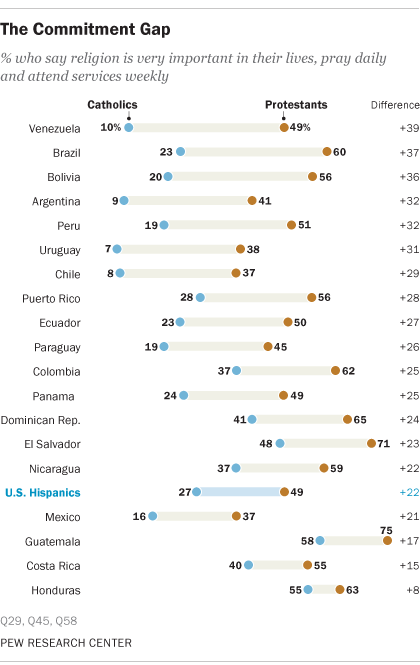
Catholics and Protestants in Latin America differ in their levels of religious observance. In every country surveyed, Protestants are more likely than Catholics to exhibit high levels of religious commitment – that is, to say they pray daily, attend worship services at least once a week and consider religion very important in their lives. Some of the widest gaps are found in Venezuela, Brazil, Bolivia, Argentina, Peru and Uruguay, where the share of adults who demonstrate high religious commitment is at least 30 percentage points higher among Protestants than among Catholics. The gaps between Protestants and Catholics on these standard measures of religious commitment are smallest, but still statistically significant, in the Central American countries of Guatemala (17 points), Costa Rica (15) and Honduras (8). (See Chapter 2 for an analysis of each component of the religious commitment index.)
Relatively few Latin Americans who are religiously unaffiliated say they attend worship services on a weekly basis. In Puerto Rico, for example, roughly a third of religiously unaffiliated adults (32%) say religion is very important in their lives, but only 3% attend religious services once a week or more.
Age and Gender Differences in Religious Commitment

In many countries across the region, women demonstrate higher levels of religious commitment than do men, and people ages 35 and older tend to be more committed than those between the ages of 18 and 34.
Protestants generally display higher levels of religious commitment than Catholics in comparable demographic categories. For example, Protestant men report attending church more frequently than do Catholic men, and young Protestants report attending religious services more frequently than do young Catholics. These patterns prevail in nearly every country where the survey’s sample sizes are large enough to permit such comparisons.
Morality and Social Views
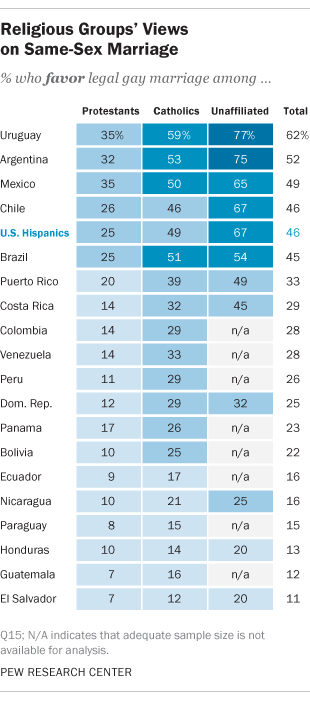
Compared with U.S. Hispanics, Latin Americans are generally more conservative when it comes to social and sexual mores. For example, in recent Pew Research polling in the United States, 46% of Hispanics support gay marriage, while 34% are opposed. In most Latin American countries, by contrast, solid majorities oppose allowing gays and lesbians to legally marry. Only in a handful of countries, such as Uruguay (62%), Argentina (52%) and Mexico (49%), do roughly half or more people favor legalizing same-sex marriage. (Same-sex marriage is currently legal in Argentina, Brazil, Uruguay and parts of Mexico, but nowhere else in Latin America.)
In most Latin American countries, opposition to same-sex marriage is more pronounced among Protestants than among Catholics. And in countries where there are adequate sample sizes to permit separate analysis of the views of religiously unaffiliated people, this group tends to be more supportive of granting marriage rights to gays and lesbians. Indeed, about two-thirds or more of the unaffiliated in Uruguay (77%), Argentina (75%), Chile (67%) and Mexico (65%) favor gay marriage.
Differences among Catholics, Protestants and the religiously unaffiliated also are apparent on other social issues. Across Latin America, Protestants generally are more likely than Catholics and the unaffiliated to say that abortion should be illegal in all or most cases, that sex outside marriage and divorce are morally wrong and that a wife is always obligated to obey her husband.
Addressing Poverty
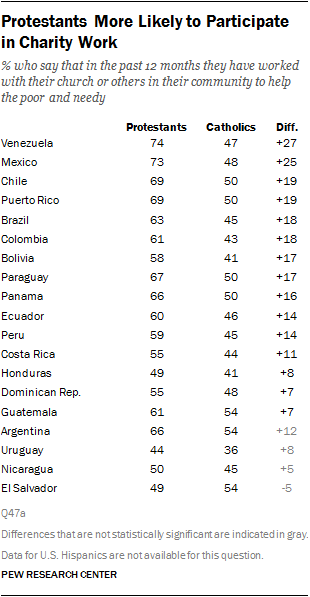
When asked what they think is the most important way for Christians to help the poor, Catholics in nearly every Latin American country point most often to charity work. By contrast, pluralities of Protestants in many countries say that “bringing the poor and needy to Christ” is the most important way to help. Overall, fewer members of either religious group say that “persuading government officials to protect the rights of the poor” is most important, though Catholics are somewhat more inclined than Protestants to take this position.
Even though Catholics are more likely than Protestants to say charity work is most important, higher percentages of Protestants report that they, personally, have joined with members of their church or others in their community to help the poor and needy. In most countries surveyed, solid majorities of Protestants say they have participated in charity work in the past 12 months. Among Catholics, roughly half or fewer report that they have done so.
In addition, among those who attend church, higher percentages of Protestants than Catholics say their house of worship helps people find jobs or provides food and clothing for those in need. (For more details, see Chapter 6.)
Pope Francis, the Catholic Church and Change
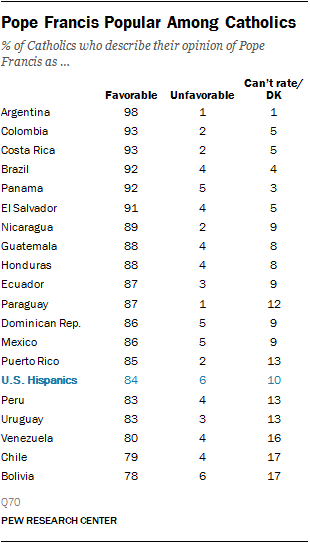
Latin Americans have widely embraced Pope Francis, the Argentine-born Jesuit bishop elected to lead the Catholic Church after Pope Benedict XVI resigned in 2013. Favorable views of the new pontiff prevail across the region, with two-thirds or more of the population in most countries expressing a positive opinion of Pope Francis when the survey was conducted in late 2013 and early 2014.
Latin American Catholics are particularly enthusiastic about Pope Francis, with clear majorities across the region rating him favorably. Indeed, in 14 of the countries surveyed, at least half of Catholics say they have a very favorable opinion of Francis.
Former Catholics, by comparison, are ambivalent about the new pope. Explicitly negative views of Pope Francis are relatively rare among this group, but so are overwhelmingly positive reactions, except in Francis’ home country of Argentina. For many former Catholics, the jury is still out. In most places surveyed, a third or more of ex-Catholics either offer no opinion on Francis or volunteer that it is too soon to assess him.
The survey also asked whether the election of Pope Francis signals a major change, a minor change or no change at all for the Catholic Church. Half or more of Catholics in 16 of the countries polled view the selection of the former Argentine bishop as a major change. Former Catholics are less certain; only in Argentina do as many as half (53%) see the new pope as representing a major change. As with the pope’s overall favorability, substantial percentages of former Catholics say it is too soon to tell whether Francis represents much change.
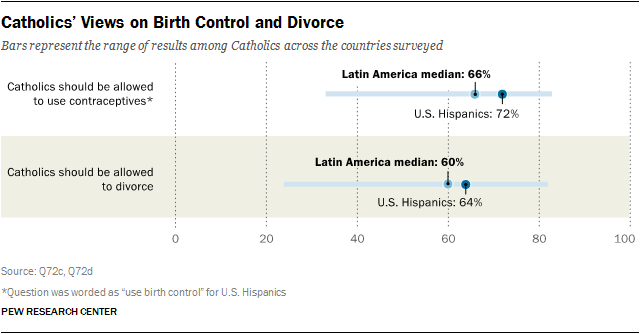
Regardless of their assessments of whether change is occurring, many Catholics think some of their church’s teachings should be revised. For instance, across Latin America, a median of 66% of Catholics say the church should allow Catholics to use artificial means of birth control, and in Chile, Venezuela, Argentina and Uruguay, roughly eight-in-ten Catholics favor a change in church teaching on contraception. In the U.S., 72% of Hispanic Catholics think the Catholic Church should permit the use of contraceptives.
There also is substantial support among Latin American Catholics (a regional median of 60%) for ending the church’s prohibition on divorce. Again, Catholics in Chile (82%), Uruguay (78%) and Argentina (77%) are among the most likely to voice support for change.
Catholics in Latin America are more divided when it comes to changes in the priesthood. Across the countries polled, a median of 48% of Catholics think priests should be allowed to marry. A similar share (regional median of 42%) say the church should permit women to be ordained as priests. On each issue, most Hispanic Catholics in the U.S. favor altering the Catholic Church’s traditional positions: 59% say priests should be allowed to marry, and 55% think women should be eligible to serve in the priesthood.
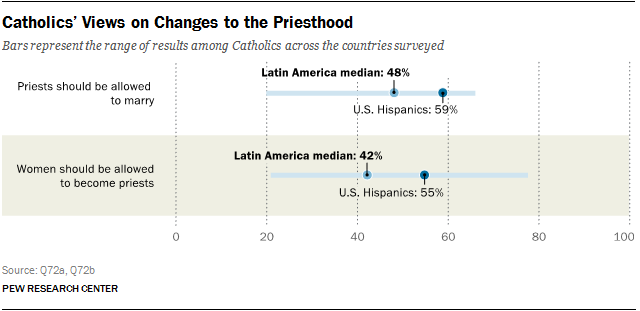
History of Religious Change

In 1910, an estimated 94% of Latin Americans were Catholic, and only about 1% were Protestant. But Catholics began declining as a share of the region’s population in the 1970s, according to Brazilian and Mexican census data and historical estimates from the World Religion Database.
As of 2014, the new Pew Research Center survey finds that 69% of Latin Americans identify as Catholic, while 19% belong to Protestant churches and 8% are religiously unaffiliated (atheist, agnostic or no particular religion). The remaining 4% include Jehovah’s Witnesses, Mormons, Muslims, Hindus, Jews, Spiritists and adherents of Afro-Caribbean, Afro-Brazilian or indigenous religions, such as Umbanda and Candomble. (See the glossary.)
Scholars of religion in Latin America offer several possible sociological explanations for the rise of Protestantism, and especially its Pentecostal variant. One theory posits that Pentecostalism’s compatibility with indigenous religions enhanced its appeal among Latin Americans. By emphasizing personal contact with the divine through faith healing, speaking in tongues and prophesying, Pentecostalism attracts those who share an affinity with indigenous religions that traditionally incorporate beliefs and practices associated with direct communication with the “spirit world.”
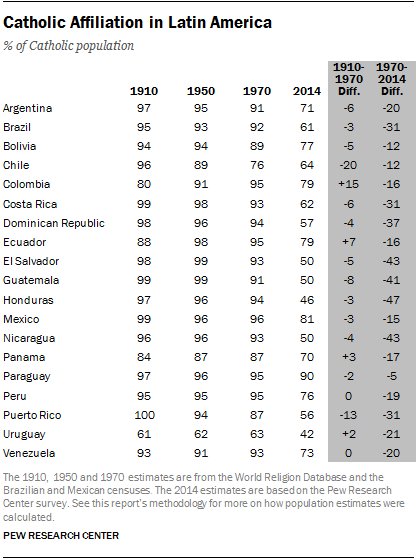
Another potential explanation highlights the practical reasons why Pentecostalism may have gained a following in the region. Pentecostals often emphasize upward social and economic mobility and thrift. Consequently, followers of Pentecostalism may see the religion as more conducive to economic prosperity.6 Historical estimates for individual Latin American countries underscore that the shift away from Catholicism is a relatively recent phenomenon in most locations. The estimates reveal only two places that experienced double-digit declines in Catholic identity between 1910 and 1970: Chile (a decline of 20 percentage points) and Puerto Rico (a 13-point decline). In Colombia, the percentage of people who identified as Catholic actually increased by 15 percentage points between 1910 and 1970.
By comparison, the period between 1970 and 2014 is marked by significant declines in the percentages of Catholics in nearly all of the countries surveyed – ranging from a 47-point drop in Honduras to a 5-point decrease in Paraguay.
The Pew Research Center previously noted post-1970 declines in Catholic identity in Brazil and Chile. (See the 2006 Pew Research report “Spirit and Power: A 10-Country Survey of Pentecostals” and the 2013 report “Brazil’s Changing Religious Landscape.”)
About the Survey
This report is based on findings from a Pew Research Center survey conducted with generous funding from The Pew Charitable Trusts and the John Templeton Foundation. The survey took place October 2013 to February 2014 among nationally representative samples in 18 countries and the U.S. territory of Puerto Rico. Together, these countries and Puerto Rico account for more than 95% of the total population of Latin America. The survey was conducted through face-to-face interviews in Spanish, Portuguese and Guarani. Sample sizes and margins of error by country are available below. For more details, see the survey methodology.
Many Pew Research staff members contributed to the development of this survey and accompanying report. James Bell and Neha Sahgal were the principal researchers and the lead authors of the report. Alan Cooperman was the lead editor. Steve Schwarzer, Fatima Ghani and Michael Robbins helped design sampling plans, monitor field work and evaluate data quality. Ghani drafted Chapter 9 (Views of Pope Francis and the Catholic Church) and Juan Carlos Donoso drafted Chapter 8 (Religion and Science). Phillip Connor drafted the sections on the history of religious change in the region. Cary Funk, Jessica Martinez, Juan Carlos Esparza Ochoa and Ana Gonzalez-Barrera assisted in questionnaire development; Martinez, Jill Carle, Kat Devlin, Elizabeth Sciupac, Claire Gecewicz, Besheer Mohamed and Angelina Theodorou assisted with number checking. Sandra Stencel, Michael Lipka and Aleksandra Sandstrom provided editorial review and copy editing. Stacy Rosenberg, Bill Webster, Adam Nekola, Ben Wormald and Diana Yoo designed the graphics and online interactive presentation. Others at the Pew Research Center who contributed to the report include Conrad Hackett, Mark Lopez, Claudia Deane, Michael Dimock, Anne Shi, Katie Simmons and Jessica Schillinger. Luis Lugo, former director of the center’s Religion & Public Life Project, was instrumental in conceiving the survey and provided guidance throughout its execution.
Fieldwork for this study was carried out by Princeton Survey Research Associates under the direction of Mary McIntosh and by Ipsos Public Affairs under the direction of Clifford Young. The questionnaire benefited greatly from guidance provided by experts on religion and public opinion in Latin America, including Matias Bargsted, Pontificia Universidad Catolica de Chile; Andrew Chesnut of Virginia Commonwealth University; Nestor Da Costa of Instituto Universitario CLAEH and Universidad Catolica del Uruguay, Uruguay; Juan Cruz Esquivel of CONICET – Universidad de Buenos Aires, Argentina; Silvia Fernandes of Universidade Federal Rural do Rio de Janeiro, Brazil; Frances Hagopian of Harvard University’s Department of Government; Fortunato Mallimaci of CONICET – Universidad de Buenos Aires, Argentina; Catalina Romero, Pontificia Universidad Catolica de Peru; and Mitchell Seligson of Vanderbilt University.
